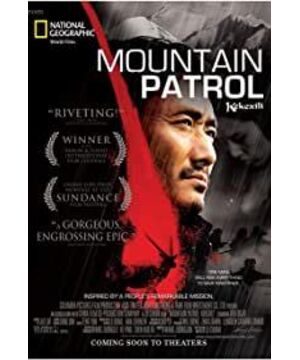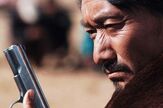"Kekexili" was filmed by director Lu Chuan. It mainly tells that in order to investigate the hunting situation of Tibetan antelope, Gayu came to Hoh Xil with the delegation as a reporter. Gayu witnessed scenes of human greed and violent conflicts between humans and the environment. . First, the mountain rangers of the Tibetan Antelope Protection Station were shot and killed by the poachers. Then they saw a tragic scene: the poachers escaped, leaving only many Tibetan antelopes with only bones. The mountain patrol team hunted down the murderer in the harsh environment, and in the end only recovered a part of the Tibetan antelope fur. On the one hand, they have to fight against the harsh natural environment, and on the other hand, they have to deal with ferocious poachers. The mountain rangers and Gayu are facing the test of life and death. In terms of the plot of the movie, director Lu Chuan pursued a realistic expression technique and did not add dramatic bridge design, so the plot of "Kekexili" was a little dull, but because of the authenticity of catching and poaching, it was even more exciting. The film tells the story of the mountain patrol team catching Tibetan antelope poaching through the perspective of reporter Ga Yu in the form of a documentary. The director used this method with careful consideration. By adopting an objective perspective and not placing the audience in the first-person position, the audience can break away from the life of the mountain patrol team members to see a deeper level and understand the director's intention. The intentions that need to be realized are gradually added in the development of the plot. The story begins with the appearance of Gayu, and the pros and cons with Japan and Thailand officially start the story. At the dining table, Gayu is reminded that the blade should be pointed at him, such tiny details. Showing the harmony and division in the mountain patrol team, it also left a foreshadowing for the bloodshed incident below. He went into the mountain to meet the team members who had been guarding the mountain alone for three years, and then met a carload of people who smuggled wool, and then recovered some of the wool and brought it with him. The guy assists the poacher. Emotions were slowly accumulating and being swallowed by quicksand, the three decided to walk back. Ritai still insisted on arresting the poachers in the face of the gun and reached a climax. The plot of the film is very bland but the emotions contained in it are constantly sublimating. Under the director's plot design, the audience lost their sympathy for the characters in the play, and strengthened their spiritual and emotional resonance with the characters. "Kekexili" is based on novel materials. It is the first time to show the Tibetan antelope poaching incident in the Hoh Xil area on the screen. The director expresses the belief of the local mountain patrol team through the incident of the Tibetan antelope. If "Kekexili" only amplifies the harmonious coexistence between man and nature, it would be difficult to obtain high praise from all walks of life. Director Lu Chuan increased the proportion of the characters in the film while protecting the Tibetan antelope. What is easier to remember in the film is definitely the dedication of the mountain rangers to the protection of Tibetan antelopes. The sub-theme of the film is the highlight of the film. The mountain patrol team does not have strong support at the national level and faces problems such as lack of funds and manpower. However, under the organization of Japan and Thailand, the local people spontaneously participated and formed the last line of defense to protect the Tibetan antelope. , On every mountain patrol team member, the audience can see the light of spirit, Ritai mentioned before his death that their hands and faces are very dirty, but their hearts are very clean. The film also digs into the factors that trigger this complex human nature. For example, Ma Zhanlin’s family was originally grazing, and the cattle and sheep could not continue due to desertification. His son was a doctor but was forced to help poachers skin. At the level of the ultimate proposition of man and nature, the director showed the audience the firm belief and courage of a group of ordinary people. The director distinguishes "Kekexili" from other films of the same type through the shaping of the characters. The characters in "Kekexili" have their own characteristics. Each character can be regarded as the protagonist and has its own unique appearance and ending. In terms of character design, the director designed the role of Gayu. The film is told from the perspective of Gayu, and the tragedy of the mountain patrol team is presented to the audience. This perspective gives the audience a great shock and mobilizes the audience's emotions. Like the glasses of the audience, Jade quietly watched the patrolmen leave or die one by one. The mountain patrol team is the image of a tough guy on the plateau created by the director. Most of the characters headed by Japan and Thailand are ruthless and persevering, but they are simple and united. This is reflected in many parts of the film, such as reminding Gayu that the blade should face him, and one of the team members was injured and trying to raise money. When the director is shooting these characters, the objective and neutral camera record will not be mixed with too much emotional guidance and moral criticism. To a certain extent, it forms an image contrast with Gayu, which has more subjective shots, and also brings a different narrative focus. In the use of audio-visual language, directors mostly use long-range and close-up shots, and more use of objective lenses. This is also the embodiment of the director's pursuit of realistic expression techniques. By shooting objective shots, the influence of the director's technique on the audience's heart is suppressed. The director uses a restrained attitude and refuses to express his own emotions to influence the audience. independent thinking. This also draws the audience's attention to the deeper themes the director wants to convey. Therefore, it is difficult to see close-up shots that easily guide the audience's emotions in the film. From the perspective of color tone selection, the color treatment of this film is mainly gray, which is more in line with the wilderness atmosphere of Hoh Xil, and is more realistic in appearance. In terms of sound design of the film, in addition to the Tibetan songs that show the regional sense of the Hoh Xil wasteland, other off-screen music appears twice in total. It can be seen that the director is striving for the realistic sense of the film, and obviously deliberately avoids all over-exaggerating emotional audio-visual modeling. means. The director's diligence is evident. In addition, the long-range scenes of "Kekexili" mostly shoot plateaus, grasslands, and snow-capped mountains, showing the style of the Hoh Xil area on the screen. These pictures present an epic picture texture, which makes the film extremely beautiful in terms of picture art. Sports shots Bringing shock, during the capture process, the camera was used hand-held many times, imitating Gayu's perspective, and the shaking picture brought a sense of urgency to the audience. To a certain extent, the film "Kekexili" can trigger the audience to discuss the many negative effects brought by modern civilization. Although the ending of the story is low-key and ends with the death of Ritai, the firm belief and courage shown by the Japanese and Thai people along the way are deeply reflected in the hearts of the audience. The brilliance displayed. To a certain extent, the film "Kekexili" can trigger the audience to discuss the many negative effects brought by modern civilization. Although the ending of the story is low-key and ends with the death of Ritai, the firm belief and courage shown by the Japanese and Thai people along the way are deeply reflected in the hearts of the audience. The brilliance displayed. To a certain extent, the film "Kekexili" can trigger the audience to discuss the many negative effects brought by modern civilization. Although the ending of the story is low-key and ends with the death of Ritai, the firm belief and courage shown by the Japanese and Thai people along the way are deeply reflected in the hearts of the audience. The brilliance displayed.
View more about Mountain Patrol reviews










